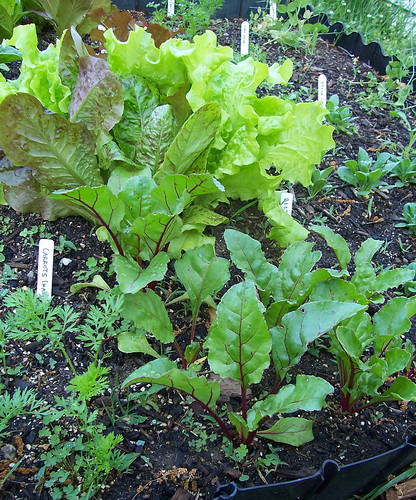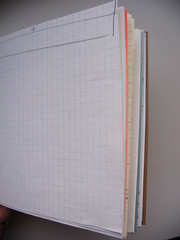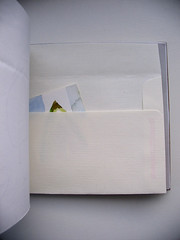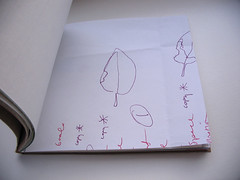 Mount Iwakiyama was hard to say but the American badger knew he'd adjust.
Mount Iwakiyama was hard to say but the American badger knew he'd adjust. Collage on postcard, Gracia Haby, 2007.
A little over a month ago now, as I read the weekend papers several days after said weekend (are you perhaps sensing a pattern here?), I came across a reference to
Sew Green in an article by Andrew Stephens and John Bailey,
Back to the future (
M, The Sunday Age, April 22, 2007). An article all about becoming a little more green. A three page spread on making your life a little simpler, and in short, a little more like your Nanna. All hail a return to the days when a "commitment to thrift, conserving resources and canny housekeeping" was the norm. Small ways in which you can make a difference today, from buying products with less packaging, making your own
all purpose cleaning products, relying upon the virtues of vinegar and bi-carb soda in place of a chemical nasties, a different chemical concoction for each room and surface in the house. Vegetable patches, string bags, walking, and generally using less, yes, that's something we all can do. And should your green thumb have deserted you, leaving you with turnips and radishes fit only for a mouse, why there are always plenty of other green alternatives to living a cleaner,
greener, simpler life.
 He travelled for some time without incident.
He travelled for some time without incident. Collage on postcard, Gracia Haby, 2007.
So, here are some of the green links found in that article for you all to discover at your leisure -
Fresh Green CleanSafer, healthier and cleaner indoor living spaces"Learn how to clean effectively and efficiently with methods that don't cause harm to people or the planet".
Plump Organic Grocery (in Yarraville, Victoria)
"We stock quality organic and bio-dynamic produce including fresh fruit and vegetables, dairy products, wine, beer, bulk grains & cereals, soy products, meat, bread, eggs, juices, and much more."
Green Living AustraliaAll about living a "Green" life, starting in our homes.Estring bags Don't cost the earth.(I've just ordered three long handled string bags in Ocean Blue, Pink Cherry Blossom and Fresh Green, and can't wait for them to arrive via snail mail.)
Sustainability VictoriaFind tips for the home and brush up on your facts while you're at it (
Wind energy - myths and facts).
And what of
Sew Green? Why, we're mentioned here: "Younger people tired of throwing away their money on poorly made mass-produced clothing and fabric products are discovering the rewards of handicrafts and clicking on to sites such as
sew green.blogspot.com and
Bee Green to learn how to make soft toys, darn socks and whip up a new blouse to wear to work".
 We thought we knew a great deal, but really we knew nothing.
We thought we knew a great deal, but really we knew nothing. Collage on postcard, Gracia Haby, 2007.
Now I'm off to get my hands on a copy of
Cradle to Cradle: Remaking the Way We Make Things by chemist and process engineer Michael Braungart and architect William McDonough, to read about the big things that can be done, to discover how buildings can be built like trees, like nature...
"Imagine a world where human industry operates exactly like a blossoming cherry tree: Every factory, every building and every product is as giving as a cherry tree with its flowers.
Imagine a world where our buildings are like trees: They cover their energy needs by harvesting solar power, produce food and oxygen, create habitat for other species and change with the seasons.
Imagine a world without pollution and waste: Products are made from materials that are beneficial for humans and their surroundings."
Believing that it is not simply enough for our actions to be 'less bad', to be 'less harmful', to the environment, Braungart and McDonough advocate, and practice, that there should be no waste whatsoever... that all waste should equal food. That all waste should give back to the biosphere. Just like trees (There's room for a book review on that one, and indeed many books currently on the market. Any takers? Care to pen a little book review on a green text you are currently perusing,
Shari,
Louise, anyone?). Oh, dear. Must dash, I fear I've bitten off more than I can chew with this one! I'll leave you to dig around further
here and
here.
 Coins in every fountain.
Coins in every fountain. Collage on postcard, Gracia Haby, 2007.
In lieu of any green photos, I have littered this post with several of my recent collages... collages of animals seeking new homes in a changing environment. I hope you like them.
 They are discussing environmental policies.
They are discussing environmental policies. Collage on postcard, Gracia Haby, 2007.
























